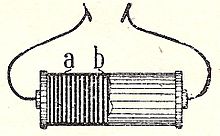Zamboni pile


The Zamboni pile (also referred to as a Duluc Dry Pile [1]) is an early electric battery, invented by Giuseppe Zamboni in 1812.
A Zamboni pile is an "electrostatic battery" and is constructed from discs of silver foil, zinc foil, and paper. Alternatively, discs of "silver paper" (paper with a thin layer of zinc on one side) gilded on one side or silver paper smeared with manganese dioxide[2] and honey might be used.[3] Discs of approximately 20 mm diameter are assembled in stacks, which may be several thousand discs thick, and then either compressed in a glass tube with end caps or stacked between three glass rods with wooden end plates and insulated by dipping in molten sulfur or pitch.[4]
Zamboni piles of more modern construction were manufactured as recently as the 1980s for providing the accelerating voltage for image intensifier tubes, particularly in military use. Today such voltages are obtained from transistorised inverter circuits powered by conventional (low-voltage) batteries.[5]
The EMF per element is approximately 0.8 V; with thousands of stacked elements, Zamboni piles have output potential differences in the kilovolt range, but current output in the nanoampere range.[2][6] The famous Oxford Electric Bell, which has been ringing continuously since 1840, is thought to be powered by a pair of Zamboni piles.[7]
See also
References
- ^ Beaty, William J. (1996). "The DuLuc Dry Pile High-Voltage Source". Archived from the original on 17 December 2023. Retrieved 15 March 2024.
- ^ a b Howard, Paul L. (1953). "A High Voltage Pile of the Zamboni Type". Journal of the Electrochemical Society. 99 (8): 333–337. doi:10.1149/1.2779746.
- ^ Stillman, Benjamin (1861). Principles of Physics. Theodore Bliss. p. 576.
- ^ Tinazzi, Massimo (1996). "Perpetual Electromotive of Giuseppe Zamboni". Archived from the original on 5 November 2019. Retrieved 18 January 2008.
- ^ "Infra-red Image Converters". The Valve Museum: The Radio Constructor. November 1961. Archived from the original on 2 December 2023. Retrieved 15 March 2024.
- ^ University of Innsbruck. "Zamboni's pile". Experimental Physics Museum. Archived from the original (Image with caption) on 27 February 2008.
- ^ "Exhibit 1 – The Clarendon Dry Pile". Oxford Physics Teaching, History Archive. Archived from the original on 7 March 2024. Retrieved 18 January 2008.

